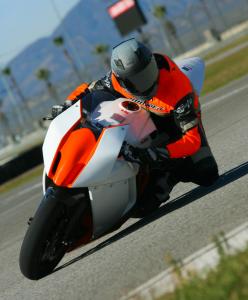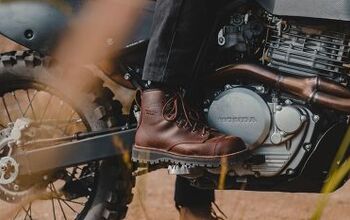2012 KTM RC8 R and RC8 R Race Spec Review: First Ride - Motorcycle.com
The final left-hander at the Auto Club Speedway in Fontana, California is a fast, sweeping transition from the flat, featureless infield to the banked straight below the grandstands. The throttle’s already at full twist when the bike hits the seam separating the two. Immediately after, the shift light on the 2012 KTM RC8 R Race Spec is demanding another gear. Without rolling off, I toe-tap the lever and the KLS quickshifter instantly grabs the next cog. Seconds later the light’s hungry for another and the quickshifter eagerly complies until the rapid succession of upshifts ends with braking then diving down the banking and into the first chicane.
I take a moment to consider the effortless advantage and seamless continuation of power the quickshifter provides compared to its manual shifting counterpart, the RC8 R streetbike I rode in the previous session. Based on 2011 MSRPs, $16,500 for the R vs. $20,000 for the Race Spec (2012 prices TBA), the quickshifter is part of a $3,500 package underlining the company’s “Ready to Race” motto.
The KLS quickshifter is only one component on a bike loaded with go-fast equipment that piecemealing together would cost more than the $3,500 KTM is asking. Akropovic Evo 4 Titanium exhaust system, slipper clutch, forged Marchesini aluminum wheels and racing WP suspension don’t come cheap but offer big advantages over the standard RC8’s configuration of stainless steel exhaust, no slipper clutch, cast aluminum wheels and non-racing WP suspension.
The Race Spec RC8 also features a differently-mapped Keihin engine management system, more engine compression, race bodywork, a 520 chain, a racing wiring harness, competition brake pads and a 31-pound weight advantage: claimed 375 lbs vs. 406 lbs, sans fuel. Both models carry 4.4 gallons of go-juice, increasing heft by 26 lbs, bringing total claimed curb weights to 401 lbs and 432 lbs for the Race Spec and R models, respectively.
As the laps accumulate and I acclimate to the performance upgrades, the confidence to push harder increases. With the help of the quickshifter I’m carrying more speed down the front straight, but the combination of racing brake pads and, especially, the WP 4618 race shock and TiAIN coated WP fork, both with modified settings for 2012, maintain the RC8 Race Spec’s composure under hard braking before navigating the chicane at the end of the straight.
Comparatively, the lesser brake pad material and different master cylinder of the R model don’t bite with as much ferocity of the Race Spec brakes, and the R’s WP suspension (unchanged from the factory setting) is overwhelmed by the high-speed braking forces.
Maneuvering in the infield section, where finesse holds sway, the two RC8s are more equally matched. The lesser weight and lighter wheels of the Race Spec bike can be felt during fast right/left transitions, but the advantage is only partly realized because the factory setting of the bars is much narrower than the streetable, comfortable setting of the R model. The wider degree setting of the R model’s bars also lends to better control in fast sweepers. I understand the aerodynamic advantage a narrow setting offers, but the trade-off is reduced leverage during side-to-side transitions as well as reduced support under hard braking. However, a Race Spec owner can adjust the clip-ons to his or her preferred position.
Also detrimental to the Race Spec is its abrupt throttle response in tighter situations requiring smooth power application. KTM claims the ECU on both the R and Race Spec were massaged for 2011 to provide better throttle application (a complaint of the RC8 since its introduction), but there’s an obvious difference in the outcome between the two. Where the R easily maintains a steady, constant throttle through the few long, sweeping corners at the Auto Club Speedway, the Race Spec could be felt surging and even the smallest inputs were met with disconcerting herky-jerkiness.
The 2011 R model was outfitted with a heavier crankshaft and flywheel, while an idle speed control cam was added to its throttle bodies to smooth airflow in the initial range of motion. KTM’s re-mapping of the Race Spec’s ECU takes into account the increased performance of its racier exhaust, air filter, etc. The Race Spec also has a slightly higher compression ratio due to thinner head gaskets. These differences could explain why the Race Spec isn’t as smooth as its R brother, but, like the setting of its clip-ons, it may as well be attributed to a racer’s preference for more immediate power.
Whether in the infield or on the high-speed banking, the slipper clutch of the Race Spec model was a welcome technology. Both bikes feature a gearbox sensor that helps the ECU control engine braking, but the lack of a slipper clutch on the R model when downshifting and braking into a tight corner is crazy-apparent when riding the two machines back-to-back. Sure, a slipper clutch is a helluva lot more useful in on-track competition, but the R model’s asking price of $17,000 should include what is now considered commonplace technology. A residual effect of the slipper clutch is a stiffer pull at the clutch lever, but the quickshifter reduces increased forearm fatigue by requiring clutch use only when downshifting.
Speaking of technological progress, both the R and Race Spec are without the latest trend — traction control. We recently concluded a test on the 2012 Yamaha R1 and Aprilia RSV4 APRC, highlighting each bike’s traction control system. With the 2012 R1 armed with traction control that leaves only the RC8, Honda CBR1000RR and Suzuki GSX-R1000 lacking this useful feature in the 1000cc sportbike category. Adding to KTM’s dilemma are its lofty MSRPs: $17 and $20 grand for a street sportbike, and especially a race bike, are big asking prices for motorcycles lacking traction control. At $14,000, the 2012 R1 with traction control retails for $2,500 less than the RC8 R.
Sure, there’s something to be said about the exotic rarity of the KTM and its unique styling, but I can think of an Italian manufacturer of equal stature in the same price range that spearheaded bringing traction control to the masses years ago and now offers the technology on the new 848 Streetfighter with only a $13,000 entry fee.
Real-world usefulness, something I lauded about the KTM after my first introduction to the bike a couple years ago, resides in the ease of its adaptability. With minor effort the RC8 owner can shift footpegs, clip-ons and the tail section from low to high placement. Both models continue this feature in 2012 with the Race Spec going a little further with multiple possibilities of footpeg personalization.
It should be noted that the Race Spec is graced with niceties such as footpegs of the short, machined, non-foldable variety and heel guards made of carbon fiber. The bodywork is race ready with no cutouts or markings for street-legal fodder such as blinkers or headlights. Brake and clutch levers are bendable, the wheels shod with Dunlop racing slicks and a rear stand is included to keep the bike upright in the pits. Also standard on the Race Spec is the GP-style shift pattern — the epitome of a race-ready motorcycle.
Both RC8s, with their narrow fuel tank/seat juncture and low weight, are easy and fun to throw around either tight sections of a road course or a gnarly uphill canyon byway. And with closely matched horsepower figures (claimed 170 crankshaft hp for the R and claimed 180 crankshaft hp for the Race Spec) either RC8 has the wherewithal to rocket out of a corner and into the next.
When asked, KTM responded with enthusiasm about entering a factory or factory-supported team in the AMA’s Superbike race class, but due to recessionary reasons, this is unlikely to happen for 2012. The company did, however, win the 2011 German Superbike Championship, lending some substantial racing credentials to the RC8.
So whether you’re looking for a new street mount or a race-ready package to launch your own racing career, KTM invites you to give RC8 a closer inspection. We took advantage of a recent Fastrack Riders track day, sponsored by KTM, where the RC8 R and RC8 Race Spec were available for anyone attending to demo in the best possible environment — a race track. To find out if KTM is hosting such an event near you, check out the KTM website.
Related Reading
2012 KTM Street Model Lineup Preview
2010 Literbike Shootout: Aprilia RSV4 Factory vs. Ducati 1198S vs. KTM RC8R
2010 KTM 1190 RC8R Review
KTM Motorcycle History
More by Tom Roderick

































Comments
Join the conversation